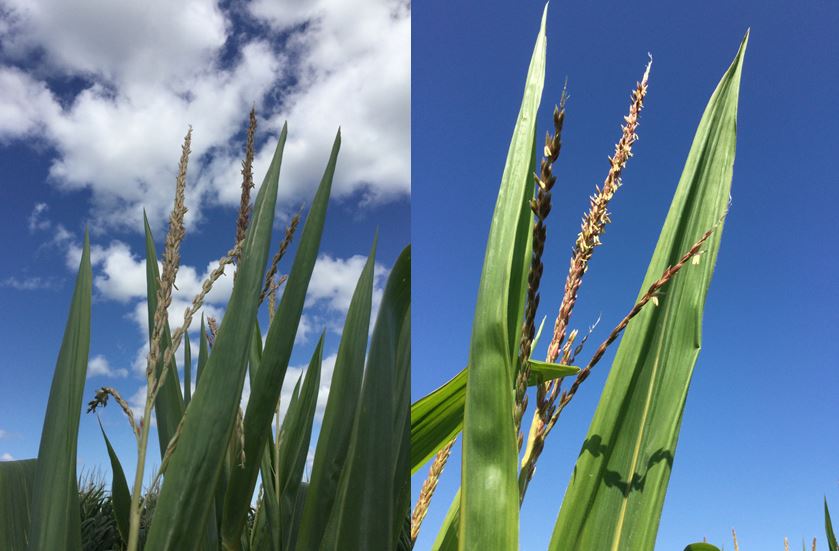PH40SW
| Denomination: | 'PH40SW' |
|---|---|
| Botanical Name: | Zea mays |
| Applicant/Holder: |
Pioneer Hi-Bred International, Inc. 8305 NW, 62nd Avenue P.O. Box 7060 Johnston, Iowa 50131 United States of America |
| Breeder: |
Maria Faricelli, Pioneer Hi-Bred International, Inc., Johnston, United States of America Kurt Olmar, Pioneer Hi-Bred International, Inc., Dallas Center, United States of America David Whitaker, Pioneer Hi-Bred International, Inc., New Holland, United States of America |
| Agent in Canada: |
Pioneer Hi-Bred Production Co. 240, 115 Quarry Park Road SE Calgary, Alberta T2C 5G9 Canada Tel: 403-440-2988 |
| Application Date: | 2021-05-03 |
| Provisional Protection:: | 2021-05-03 |
| Application Number: | 21-10496 |
Variety Description
Variety used for comparison: 'PH1K0H1'
Summary: The brace roots on the stems of 'PH40SW' have a strong intensity of anthocyanin colouration whereas those of 'PH1K0H1' have very strong intensity of anthocyanin colouration. The tassel of 'PH40SW' have moderately sparse density of spikelets whereas that of 'PH1K0H1' have a medium density of spikelets. The main axis above the lowest lateral branch on the tassel of 'PH40SW' is a medium length whereas that of 'PH1K0H1' is long. The lateral branch on the tassel of 'PH40SW' is short whereas that of 'PH1K0H1' is a medium length. The husk covering the tip of the ear of 'PH40SW' is a medium length whereas that of 'PH1K0H1' is long. The ear wings for 'PH40SW' are present on a high percentage of plants whereas those of 'PH1K0H1' are present on a low percentage of plants. Including the kernels, the ear of 'PH40SW' has a larger diameter than that of 'PH1K0H1'. The ear of 'PH40SW' has many rows of kernels whereas that of 'PH1K0H1' has a medium number of rows of kernels. The glumes of the cob of 'PH40SW' have medium intensity of anthocyanin colouration whereas those of 'PH1K0H1' have weak intensity of anthocyanin colouration.
Description:
PLANT: inbred yellow variety, small ratio of height of insertion of peduncle of upper ear to plant height, anthesis occurs very late in season, silk emergence occurs late in season
STEM: absent or very slight degree of zig-zag, strong intensity of anthocyanin colouration on brace roots
LEAF BLADE (JUST ABOVE UPPER EAR): strong undulation of margin, small angle with stem, slightly recurved
TASSEL: few primary lateral branches, moderately sparse spikelets on middle third of main branch, medium length main axis above lowest lateral branch, long main axis above highest lateral branch
LATERAL BRANCHES: straight, small angle with main axis, short
GLUME: absent or very weak intensity of anthocyanin colouration at base, medium intensity of anthocyanin colouration at apex and middle
ANTHER (ON MIDDLE THIRD OF MAIN BRANCH OF TASSEL): weak intensity of anthocyanin colouration
EAR: weak intensity of anthocyanin colouration of silks, medium length husk (extends one quarter length of ear above tip), cylindrical shape, many rows of grain, medium intensity of anthocyanin colouration on glumes of cob
EAR WINGS: present on a high percentage of plants, medium length
KERNEL: intermediate type, yellow on top, yellow orange on dorsal side
TILLERING: present on a medium percentage of plants
Origin & Breeding History: 'PH40SW' was developed by Pioneer Hi-Bred International, Inc. using a pedigree method of plant breeding. In 2011, a cross was conducted between proprietary inbred lines in Salinas, Puerto Rico with a subsequent backcross to the motherline. The BCF1 generation was selfed with subsequent ear to row selections conducted from the BCF1 to BCF6 generations. 'PH40SW' was selected based on tassel size, pollen production, germination ability, stalk lodging resistance, late season plant health, yield in hybrid combination, grain quality, as well as disease and insect resistance. The BCF7 seed was bulked as breeder seed in New Holland, Pennsylvania, USA in 2015.
Tests & Trials: The comparative trial for 'PH40SW' was conducted in Coteau-du-Lac, Quebec during the 2021 growing season. The trial was planted in a RCB design with 3 replicates. Each replicate consisted of one 3 metre long row with 76 cm between the rows. With approximately 20 plants per row, there was a total of 50 to 60 plants per variety. Measured characteristics were based on a minimum of 27 measurements per variety. Mean differences were significant at the 5% probability level based on Student's T-tests. Results were supported by the official technical examination report 202000313, purchased from the Plant Variety Protection Office in Washington, District of Columbia, USA.
Comparison table for 'PH40SW' with reference variety 'PH1K0H1'
Ear diameter (including kernels) (cm)
| 'PH40SW' | 'PH1K0H1' | |
|---|---|---|
| mean | 4.43 | 4.19 |
| std. deviation | 0.19 | 0.26 |
Click on image for larger view

Corn: 'PH40SW' (left) with reference variety 'PH1K0H1' (right)
Click on image for larger view

Corn: 'PH40SW' (top) with reference variety 'PH1K0H1' (bottom)
- Date modified: